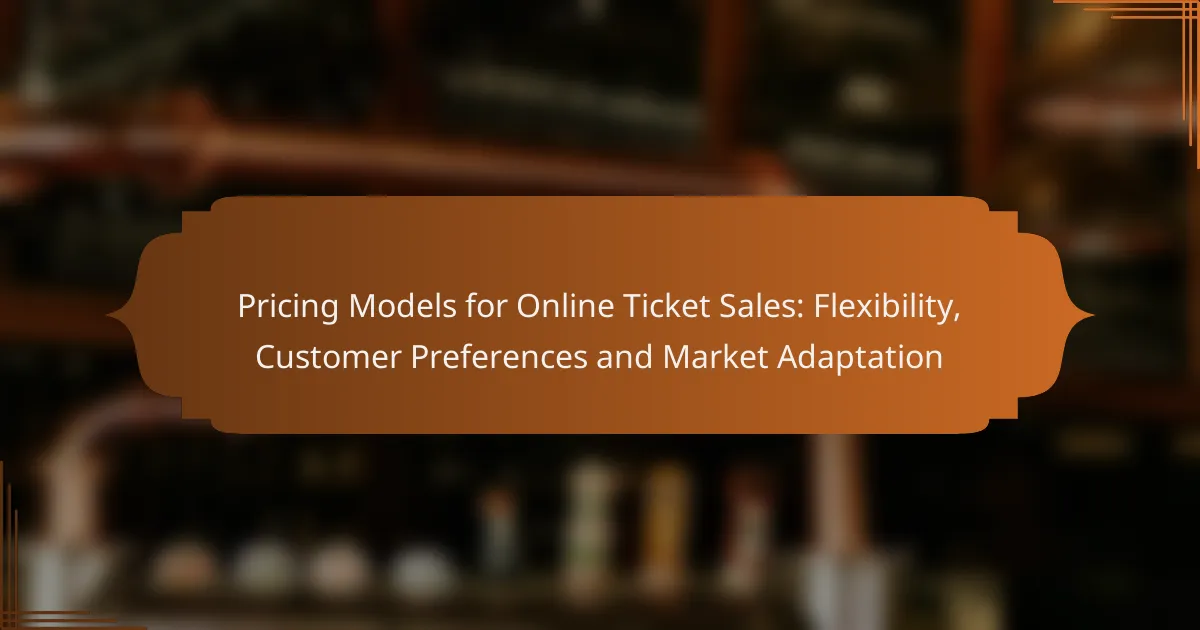In the competitive landscape of online ticket sales, selecting the right pricing model is essential for maximizing revenue and catering to customer preferences. Models such as dynamic pricing, tiered pricing, and subscription-based options allow businesses to adapt to market demands while addressing the unique needs of their audience. By understanding customer behavior and market dynamics, sellers can implement strategies that enhance customer satisfaction and drive sales.

What Are the Most Effective Pricing Models for Online Ticket Sales?
The most effective pricing models for online ticket sales include dynamic pricing, tiered pricing, subscription-based pricing, freemium models, and pay-what-you-want. Each model offers unique advantages and can be tailored to meet customer preferences and market demands.
Dynamic Pricing
Dynamic pricing adjusts ticket prices in real-time based on demand, competition, and other market factors. This model allows sellers to maximize revenue by increasing prices during peak demand and lowering them during slower periods.
For example, airlines and event venues often use dynamic pricing to respond to changes in ticket sales, with prices fluctuating based on factors like time to event and remaining inventory. However, it’s crucial to communicate these price changes clearly to avoid customer frustration.
Tiered Pricing
Tiered pricing involves offering tickets at different price levels based on features or benefits, such as seating location or access to exclusive areas. This model caters to a wide range of customer budgets and preferences.
For instance, a concert might offer general admission tickets at a lower price while charging more for VIP packages that include perks like early entry or meet-and-greet opportunities. This approach can enhance customer satisfaction by providing options that match their willingness to pay.
Subscription-Based Pricing
Subscription-based pricing allows customers to pay a recurring fee for access to a set number of events or tickets over a specified period. This model can create a loyal customer base and provide predictable revenue for sellers.
For example, a theater might offer a subscription that includes tickets to multiple shows throughout the season at a discounted rate. It’s essential to ensure that the subscription offers value, as customers will expect to save money compared to purchasing tickets individually.
Freemium Models
Freemium models provide basic access to events or services for free, while charging for premium features or experiences. This approach can attract a larger audience and convert some users into paying customers over time.
For instance, a festival might offer free entry to general areas while charging for access to VIP lounges or exclusive performances. It’s important to balance free offerings with compelling paid options to encourage upgrades.
Pay-What-You-Want
The pay-what-you-want model allows customers to choose how much they want to pay for a ticket, often with a suggested minimum price. This approach can foster goodwill and increase sales from customers who might not otherwise attend.
For example, some theaters or art galleries have successfully implemented this model, allowing patrons to contribute based on their financial situation. However, sellers should be cautious, as this model may lead to lower average revenues if not managed effectively.

How Do Customer Preferences Influence Pricing Strategies?
Customer preferences play a crucial role in shaping pricing strategies for online ticket sales. Understanding what customers value, their sensitivity to price changes, and their purchasing behavior can help businesses tailor their pricing models effectively.
Value Perception
Value perception refers to how customers view the worth of a ticket relative to its price. Factors such as the event’s popularity, seating options, and additional benefits (like early access or exclusive content) can enhance perceived value. For instance, premium seating at a concert may justify a higher price if customers believe the experience is significantly better.
To optimize value perception, businesses should communicate the unique benefits of their offerings clearly. Highlighting exclusive features or limited-time offers can create a sense of urgency and increase perceived value.
Price Sensitivity
Price sensitivity indicates how responsive customers are to changes in ticket prices. Generally, customers with lower disposable income or those purchasing for larger groups tend to be more price-sensitive. For example, a family looking to attend a sports event may seek discounts or special promotions to make the outing affordable.
Businesses can assess price sensitivity through market research, surveys, or analyzing past sales data. Implementing tiered pricing models can cater to different segments, allowing for both budget-conscious buyers and those willing to pay more for premium experiences.
Purchase Behavior
Purchase behavior encompasses the decision-making process customers go through when buying tickets. Factors such as timing, urgency, and the ease of the purchasing process can significantly influence their choices. For instance, customers may be more likely to buy tickets during promotional periods or when they perceive limited availability.
To enhance purchase behavior, streamline the ticket-buying process by minimizing steps and offering multiple payment options. Additionally, leveraging data analytics to understand peak buying times can help in crafting targeted promotions that align with customer behavior patterns.

What Factors Affect Market Adaptation in Ticket Pricing?
Market adaptation in ticket pricing is influenced by various factors, including competitor pricing, the type of event, and overall market demand. Understanding these elements helps sellers adjust their strategies to maximize revenue and meet customer expectations.
Competitor Pricing
Competitor pricing plays a crucial role in how ticket prices are set. Sellers must regularly monitor prices offered by similar events or venues to remain competitive. If a competitor lowers their prices, it may prompt others to follow suit to avoid losing customers.
For example, if a concert venue nearby offers tickets at a lower price, event organizers may need to consider adjusting their own pricing strategy. This could involve offering discounts or bundling tickets with additional perks to attract buyers.
Event Type
The type of event significantly influences ticket pricing strategies. High-demand events, such as major concerts or sports finals, often command higher prices due to their popularity. Conversely, niche or less popular events may require lower pricing to entice attendees.
For instance, a well-known artist’s concert may see ticket prices ranging from $50 to $300, while a local theater production might price tickets between $10 and $30. Understanding the event’s appeal helps in setting appropriate price points.
Market Demand
Market demand is a key factor in determining ticket prices. When demand is high, sellers can increase prices, while low demand may necessitate discounts or promotions. Tracking trends and consumer behavior is essential for effective pricing strategies.
For example, during peak seasons or holidays, demand for tickets often rises, allowing for higher pricing. Conversely, during off-peak times, sellers might need to offer incentives, such as early bird discounts or group rates, to boost sales.

What Are the Benefits of Flexible Pricing Models?
Flexible pricing models offer significant advantages by allowing businesses to adjust ticket prices based on demand, customer behavior, and market conditions. This adaptability can lead to increased profitability and enhanced customer experiences.
Increased Revenue
Flexible pricing models can boost revenue by optimizing ticket prices according to real-time demand. For example, during peak times, prices can be raised to maximize income, while off-peak periods can see discounts to encourage sales. This dynamic approach can lead to revenue increases of up to 20-30% in competitive markets.
Implementing tiered pricing strategies, such as early bird discounts or last-minute deals, can also attract a wider range of customers. By appealing to different segments, businesses can fill more seats and generate additional income.
Improved Customer Satisfaction
When customers perceive they are getting a good deal, their satisfaction levels typically rise. Flexible pricing allows businesses to offer personalized pricing options, catering to various budgets and preferences. For instance, offering family packages or student discounts can enhance the overall customer experience.
Moreover, transparent pricing strategies that explain price fluctuations can build trust with customers. Clear communication about why prices change helps customers feel valued and understood, leading to repeat business.
Better Inventory Management
Flexible pricing models facilitate more effective inventory management by aligning ticket prices with demand patterns. This approach helps prevent overbooking and underutilization of resources. For example, if a particular event is not selling well, lowering prices can stimulate interest and increase sales.
Utilizing data analytics to track sales trends can further enhance inventory management. By analyzing customer purchasing behavior, businesses can anticipate demand and adjust pricing strategies accordingly, ensuring optimal inventory levels and minimizing waste.

How Do Technology and Data Analytics Shape Pricing Models?
Technology and data analytics significantly influence pricing models for online ticket sales by enabling dynamic pricing strategies that respond to real-time market conditions and customer behavior. These advancements allow companies to optimize revenue and enhance customer satisfaction through tailored pricing approaches.
Real-Time Data Analysis
Real-time data analysis involves continuously monitoring various factors such as demand fluctuations, competitor pricing, and customer purchasing patterns. By leveraging this data, ticket sellers can adjust prices instantly to maximize sales opportunities and respond to market changes effectively.
For example, if a concert is nearing sell-out status, prices can be increased to reflect heightened demand. Conversely, if ticket sales are slow, discounts may be offered to stimulate purchases. This flexibility can lead to improved revenue outcomes and better inventory management.
Machine Learning Algorithms
Machine learning algorithms enhance pricing models by analyzing historical data to predict future trends and customer preferences. These algorithms can identify patterns that human analysts might overlook, allowing for more accurate pricing strategies tailored to specific customer segments.
For instance, a ticketing platform might use machine learning to determine that certain demographics are more likely to purchase tickets at specific price points. By applying these insights, companies can implement personalized pricing, increasing the likelihood of conversion while optimizing overall sales.

What Are the Challenges of Implementing Flexible Pricing?
Implementing flexible pricing in online ticket sales presents several challenges, including customer acceptance, technical integration, and market volatility. Businesses must navigate these obstacles to effectively adapt their pricing strategies to meet consumer demand and maximize revenue.
Customer Acceptance
One of the primary challenges is gaining customer acceptance of flexible pricing models. Customers often prefer predictable pricing and may view fluctuating prices as unfair or exploitative. To address this, companies can educate consumers about the benefits of flexible pricing, such as better deals during off-peak times.
Offering transparency in how prices are determined can also help build trust. For instance, explaining that prices may vary based on demand or availability can make customers more comfortable with the concept.
Technical Integration
Integrating flexible pricing into existing ticketing systems can be complex and resource-intensive. Businesses need to ensure their platforms can handle dynamic pricing algorithms and real-time data analysis. This often requires investment in technology and training for staff to manage these systems effectively.
Additionally, companies should consider the user experience when implementing these changes. A seamless interface that allows customers to easily understand and navigate pricing variations is crucial for maintaining sales and customer satisfaction.
Market Volatility
Market volatility can significantly impact the effectiveness of flexible pricing strategies. Factors such as economic shifts, competitor pricing, and changes in consumer behavior can lead to unpredictable demand. Companies must be agile and ready to adjust their pricing models in response to these fluctuations.
To mitigate risks, businesses can conduct regular market analyses and gather customer feedback. This information can inform pricing adjustments and help maintain competitiveness in a rapidly changing environment.



